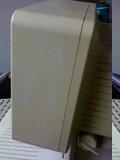

retr0bright is a concoction that is supposed to remove the yellowing of ABS plastics used in old computers, video game systems, etc. Here are my experiences with making my own and using it on a variety of systems.
Gathering the ingredients for making retr0bright wasn't all that trivial. I ended up making the original formula documented on the retr0bright site above. I could not find anywhere locally, including pharmacies, hair salons, etc. that carried anything >3% concentration hydrogen peroxide. I ended up ordering 12% concentration through Amazon. Glycerine was only available over the counter at a pharmacy. The rest of the ingredients were available locally without too much trouble, although what aisle is Xanthum gum at in the local grocery store again?
The default recipe makes approximately 2 cups, which is a lot if you're applying to the surface of a device, but not a lot if you're planning on submerging a reasonably sized piece plastic. I ended up simply applying the gel like substance to the surfaces of several devices: a //c, //c monitor, Mac Extended II keyboard, C64 breadbox case, PowerMac 8500 plastic bezels, and the front bezel of a Mac SE. When applying retr0bright, the instructions say to apply it to the surface, then leave the surface out in UV liight for 1-2 days, cleaning off the retr0bright residue after that time period.


A couple things that might seem straight forward, but deserve emphasizing. An inconsistent solution that has not been sufficiently mixed will not result in consistent "whitening"/removal of the yellowing. Similarly inconsistent application will result in inconsistent "whitening"/removal of yellowing.
Here is an example of some streaks and inconsistent whitening:


Retr0bright works, but it's no silver bullet. A C64 breadbox top came out quite nice, but the //c - which was extremely yellow to begin with - simply became less yellow, and inconsistently colored at that. With additional applications and UV lamps, I'm confident better results can be obtained. I also believe that mixing up suffcient quantities to actually submerge the surface in H2O2 + oxy cleaner would have more consistent results than attempting to mix up and apply the gel form consistently. If using the gel form, I'd recommend extremely liberal application.
Ultimately, I don't believe the retr0brighting process was worthwhile. It would be nice to have pristine looking equipment, but I'm much more concerned about the functionality, personally. The time and cost of obtaining the ingredients, mixing it up, applying, and most importantly cleaning it off has been an interesting learning experience, but I don't believe the results I've obtained have justified the time spent. I'm confident that with subsequent batches, and taking the time to develop the proper skills in application would reduce the time taken and produce much better results. But I'm not convinced that's really worthwhile in small volumes.